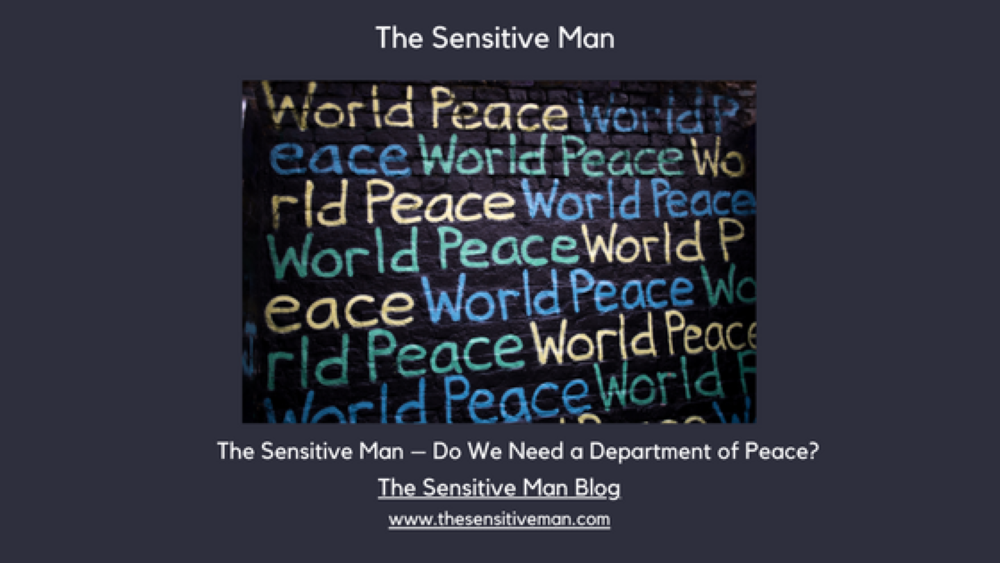|
A Blog about Sensory Processing Sensitivity from the Worldview of a High-Sensing Male
Several years back, I remember a call for the government to form a department of peace. What surprised me was that this has occurred throughout the history of the United States, very often due to a recent war or during a military conflict. This movement started as far back as 1793 by Dr. Benjamin Rush, a founding father, and Quaker clergyman. Other notable attempts have been introduced by esteemed congresspeople such as Everett Dirksen (late 40s), Senator Vance Harke (late 60s), Dennis Kucinich in 2001, and most recently, Barbara Lee in 2013. In addition, many celebrities have attached their names to this movement, including Walter Cronkite, Marianne Williamson, Willie Nelson, Yoko Ono, and Joaquin Phoenix. Invariably, these initiatives don’t pass into law, likely because of a strong military-industrial complex lobby and a continuing jingoistic American public. Nevertheless, these attempts to at least study conflict and conflict resolution, teach peaceful negotiation, and learn via science ways to arbitrate disagreements would have great merit in a time where there are implacable schisms in almost every imaginable area – religious, political, social, business and any national discussion. It is frustrating to note that in an age that has produced AI, we don’t have the common sense to navigate our disagreements. The History of Peace Movements To study peace, it might be useful to define what the objective might be. What is peace? You might simply describe peace as a quality of a society, nation, group, or individual operating harmoniously. It could include a lack of hostility, safety and recognition, equality and fairness, and an absence of war or agitated conflict. This is not a static state of bliss but an active state of negotiation, compromise, and mutual respect. Our word peace has roots in the Hebrew Shalom, meaning safety, welfare, prosperity, security, good fortune, and friendliness. Over the years, various attempts in the US to create sustainable peace movements have often failed when presented to the government -even if the idea is wildly popular, as was the case in the early 2000s leading up to American involvement with Iraq, post 911. But then, despite the presence of 10 million marchers, the government was oblivious and marched on to war. Does that make the attempts at a peace movement futile? On the contrary, they serve as a balancing point to militarization and a counterweight to knee-jerk military action. In some ways, they can provide a bargaining chip to ensure some just peace is implemented, albeit post-conflict. Emerson and Thoreau were part of an earlier peace movement spurred by the Mexican-American War. Thoreau even wrote an essay on civil disobedience, which inspired both Tolstoy and Martin Luther King, Jr. Quakers, a religious group where peace is a foundational element to their belief systems, have played important roles in peace movement history in the US. Even the woman who wrote The Battle Hymn of the Republic, Julia Ward Howe, decried the use of war to settle disagreements and the loss of husbands, fathers, and sons to the destruction of war. William James, the father of American psychology, extolled the value of maintaining political unity and civic virtue without war or the threat of war. Yet, none of this was enough. Even with all of the notable figures supporting peace, America entered the twentieth century only to witness the bloodiest century in the history of humanity. Two world wars, countless regional and geo-political conflicts, and no sign that humans had evolved to such an extent as to prevent wars. We Need to Learn How to Do Conflict Resolution So what is missing? If you polled most people around the world, the vast majority would wish for a world where peace was the norm. So why can’t we get there? The desire is there, perhaps, even the will, but how do we do this? I question if there can be a world free of conflict, but at least we can have a world free of war. The solution is to find and promote powerful and effective conflict-resolution tools. What would help is a concerted cross-discipline scientific study on the elements of peace and the art of conflict resolution—evidence-based, practical tools for avoiding escalated conflict and ways to diffuse disputes that lead to war quickly. This will not be a magic formula but will build over time a body of knowledge that can serve as inputs to educational programs for schools, research material for perpetual studies on peace, and encourage something like a peace propaganda movement that extolls the virtues of peace and the sanctity of life. We must train our children and people to find inner peace. This can be done without religious attachments and kept objective with scientific validation. By socializing this ideology of peace first, over time, a generation of children will be taught the finer points of conflict resolution and how to maintain inner peace in the face of stress and distress. This will promote conflict studies, a foundation for propagating peace studies programs throughout universities and think tanks. This effort may take several generations of exposure to take root firmly. A Department of Peace (perhaps named differently) would be the focal point of all government efforts to promote conflict resolution and non-military solutions to conflict. In the interim, we would need to develop programs that would work with military leaders to quickly de-escalate armed conflicts and bring parties to the negotiation table. At some point in the future, even this could be eliminated. Is There Any Hope for This? All of this sounds great, but is it likely to happen? Considering the present conditions, we live in, with the great polarization within humanity, the enormous investment we have in the military, the influence of the military-industrial complex, and the glorification of war in popular media, this seems unlikely. But, unless we take significant steps towards a peaceful world, I fear humanity is in grave danger. Unfortunately, we often forget we are but one nuclear war away from the annihilation of humanity. This must change. We need to understand at a deep level what causes aggression. Is it fear, is it greed, or is it ego-based dynamics? What insecurity drives us to this insanity? How can we prevent conflict if we don’t understand the root of conflict and the subsequent emotional overreaction? We spend trillions of dollars on war, so why not earmark millions to study peace? Part of maintaining peace is finding ways of negotiation that do not produce zero-sum outcomes. Negotiation need not be about one side winning as the other loses. Instead, we have to develop objective negotiation methods that consider all sides. Producing compromised yet fair results mean going the extra mile to keep the peace. We must emphasize cooperation and not always make life a merciless competition. We work better if we cooperate because collaboration is about raising all ships. We need to focus through education and practice-- not just rhetoric, on encouraging a kinder, gentler world. The stakes are too high not to try. And remember, pacifism is not passivity. Resigning to the archaic notion that there are just wars and that they are inevitable is simply a self-fulfilling prophecy. We must reach a point for us to evolve to reject war and the disturbance of the peace. As John Lennon famously sang, “Give peace a chance.” A department of peace would be a good start.
0 Comments
Leave a Reply. |
AuthorBill Allen currently lives in Bend, Oregon. He is a certified hypnotist and brain training coach at BrainPilots.com. He believes that male sensitivity is not so rare, but it can be confounding for most males living in a culture of masculine insensitivity which teaches boys and men to disconnect from their feelings and emotions. His intent is to use this blog to chronicle his personal journey and share with others. Archives
July 2024
Categories
All
|


 RSS Feed
RSS Feed
